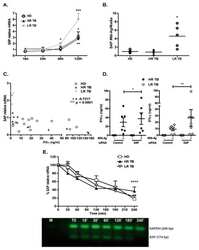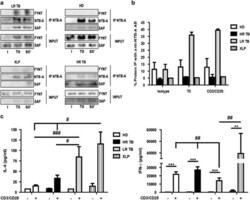14-9888-82
antibody from Invitrogen Antibodies
Targeting: SH2D1A
DSHP, EBVS, IMD5, LYP, MTCP1, SAP, XLP, XLPD
Antibody data
- Antibody Data
- Antigen structure
- References [3]
- Comments [0]
- Validations
- Other assay [4]
Submit
Validation data
Reference
Comment
Report error
- Product number
- 14-9888-82 - Provider product page

- Provider
- Invitrogen Antibodies
- Product name
- SAP (SLAM-Associated Protein) Monoclonal Antibody (10C4.2), eBioscience™
- Antibody type
- Monoclonal
- Antigen
- Other
- Description
- Description: This 10C4.2 monoclonal antibody reacts with human SLAM-associated protein (SAP). Upon SLAM receptor ligation, this 16-kDa SH2 domain-containing adaptor protein recruits Fyn tyrosine kinase, which phosphorylates the receptor to activate downstream signaling events. SAP is expressed in T, NK, and NKT cells, as well as eosinophils and platelets. This protein has also been detected in B cells and tumor cell lines such as Jurkat and Raji. Studies demonstrate that SAP expression in T follicular helper cells is required for germinal center formation. Moreover, this protein is involved in NKT cell development, Th1/Th2 differentiation, and controlling NK cytotoxicity. The role of SAP in B cells, however, is currently under investigation. Finally, deletion of the gene encoding SAP, SH2D1A, results in X-linked lymphoproliferative disease in humans. Applications Reported: This 10C4-SAP (10C4.2) antibody has been reported for use in immunoblotting and immunocytochemistry (ICC). Applications Tested: This 10C4.2 antibody has been tested by immunoblotting of reduced cell lysate prepared from Jurkat cells. This can be used at less than or equal to 5 µg/mL. It is recommended that the antibody be carefully titrated for optimal performance in the assay of interest. Purity: Greater than 90%, as determined by SDS-PAGE. Aggregation: Less than 10%, as determined by HPLC. Filtration: 0.2 µm post-manufacturing filtered.
- Reactivity
- Human
- Host
- Mouse
- Isotype
- IgG
- Antibody clone number
- 10C4.2
- Vial size
- 100 μg
- Concentration
- 0.5 mg/mL
- Storage
- 4°C
Submitted references Restimulation-induced T-cell death through NTB-A/SAP signaling pathway is impaired in tuberculosis patients with depressed immune responses.
Germinal center T follicular helper cell IL-4 production is dependent on signaling lymphocytic activation molecule receptor (CD150).
Cell surface receptors Ly-9 and CD84 recruit the X-linked lymphoproliferative disease gene product SAP.
Hernández Del Pino RE, Pellegrini JM, Rovetta AI, Peña D, Álvarez GI, Rolandelli A, Musella RM, Palmero DJ, Malbran A, Pasquinelli V, García VE
Immunology and cell biology 2017 Sep;95(8):716-728
Immunology and cell biology 2017 Sep;95(8):716-728
Germinal center T follicular helper cell IL-4 production is dependent on signaling lymphocytic activation molecule receptor (CD150).
Yusuf I, Kageyama R, Monticelli L, Johnston RJ, Ditoro D, Hansen K, Barnett B, Crotty S
Journal of immunology (Baltimore, Md. : 1950) 2010 Jul 1;185(1):190-202
Journal of immunology (Baltimore, Md. : 1950) 2010 Jul 1;185(1):190-202
Cell surface receptors Ly-9 and CD84 recruit the X-linked lymphoproliferative disease gene product SAP.
Sayós J, Martín M, Chen A, Simarro M, Howie D, Morra M, Engel P, Terhorst C
Blood 2001 Jun 15;97(12):3867-74
Blood 2001 Jun 15;97(12):3867-74
No comments: Submit comment
Supportive validation
- Submitted by
- Invitrogen Antibodies (provider)
- Main image

- Experimental details
- NULL
- Submitted by
- Invitrogen Antibodies (provider)
- Main image

- Experimental details
- NULL
- Submitted by
- Invitrogen Antibodies (provider)
- Main image

- Experimental details
- NULL
- Submitted by
- Invitrogen Antibodies (provider)
- Main image

- Experimental details
- 5 The NTB-A/SAP pathway impairs RICD in LR TB patients. PBMCs from healthy donors (HD, N =3), high responder tuberculosis patients (HR TB, N =3), low responder tuberculosis patients (LR TB, N =3) and SAP-deficient (XLP, N =1) patients were stimulated with Mtb -Ag for 5 days. Then, the cells were washed and cultured with RPMI plus hrIL-2. After 7 days, lymphocyte enrichment was performed by centrifugation over Ficoll-Hypaque and afterwards cells were stimulated with alpha-CD3+alpha-CD28 for 1 h. ( a ) Immunoprecipitation of NTB-A. The immunoprecipitates were separated by SDS-PAGE and immunoblotted for the presence of SAP, NTB-A and FYNT. SAP and FYNT expression in input lysates are shown for comparison (bottom) (I=Isotype, T0=unstimulated cells and 60''=stimulated cells with alpha-CD3+alpha-CD28 for 1 h). The images show cropped lines corresponding to NTB-A, SAP and FYNT. ( b ) Polyacrylamide gels were scanned, densitometry was performed, and the results were expressed as % FYNT IP with anti-NTB-A=([FYNT AU Immunoprecipitated fraction (IP)/(FYNT AU IP+FYNT AU Non-Immunoprecipitated fraction]) x 100. ( c ) PBMCs from HD ( N =6), HR ( N =7), LR ( N =5) tuberculosis patients and XLP ( N =3) patients were stimulated with Mtb -Ag for 5 days. Then, cells were washed and cultured with RPMI plus hrIL-2. After 7 days, lymphocyte enrichment was performed by centrifugation over Ficoll-Hypaque and cells were stimulated with alpha-CD3+alpha-CD28 for 24 h. Cell-free supernatants were collec
 Explore
Explore Validate
Validate Learn
Learn Western blot
Western blot Other assay
Other assay